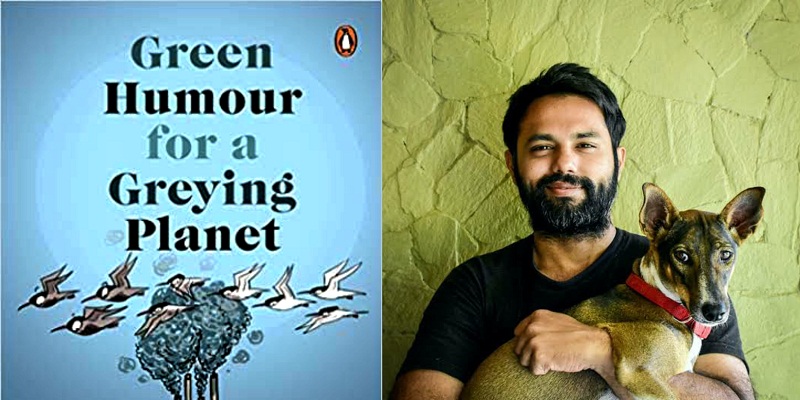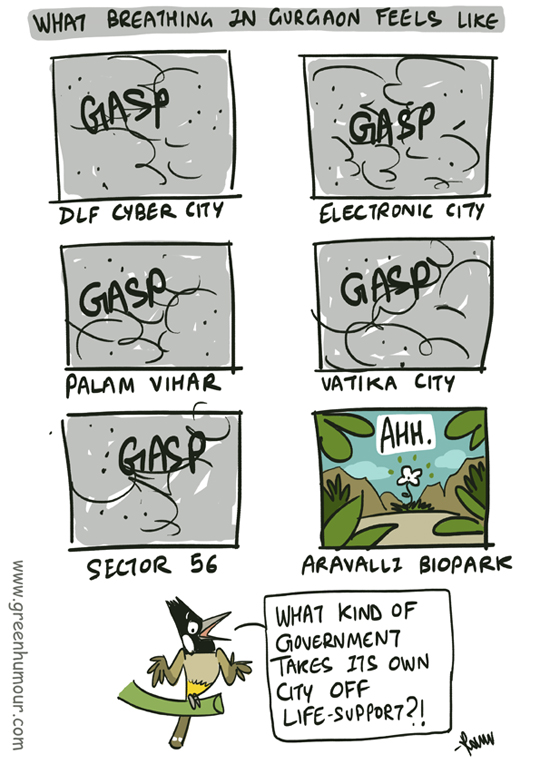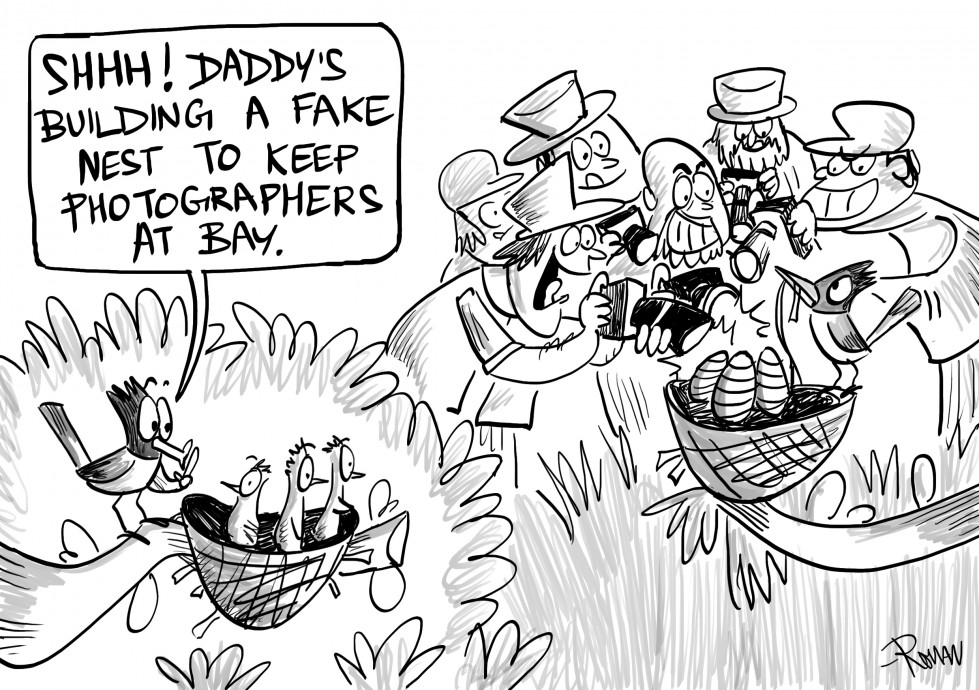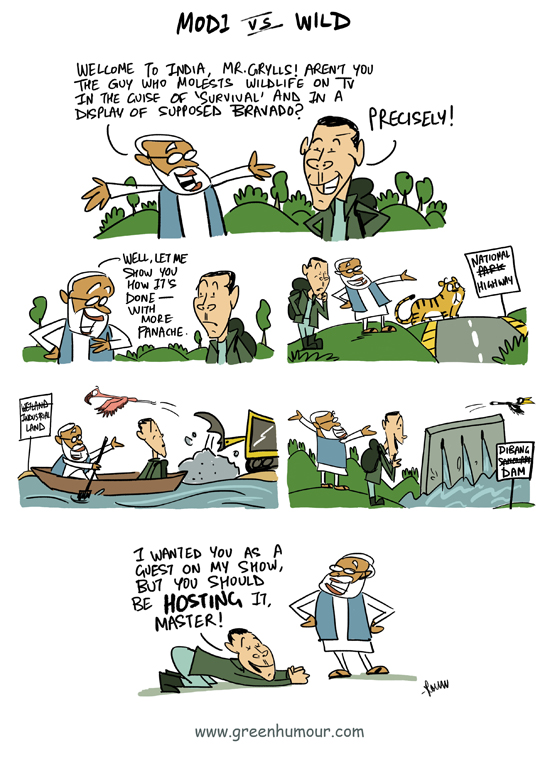A well-known cartoonist hailing from Nagpur, Rohan Chakravarty is the creator of Green Humour, a series of cartoons, comics and illustrations on wildlife and environment. He is a dentist by profession and an artist by passion who has recently launched his new book titled Green Humour for a Greying Planet which is a curation of gag cartoons and comic strips based exclusively on wildlife and nature.
Published by Penguin, Green Humour for a Greying Planet is currently the #1 Bestseller in the Environment & Nature category at Amazon.. Chakravarty’s works are greatly appreciated and supported by eminent personalities including actor, producer and Wildlife Trust of India ambassador Dia Mirza who reviewed the book and said, “Rohan is gifted with the ability to convey hard truths about science and people with a skill that is rare and unique. [This book is] a must read.”
Chakravarty is someone who stands out with his humour to address and highlight the endangered animals and holds a power to present facts and data which we have never heard about before. He is well known for his satirical approach to address various issues from environment to prime minister’s Niti Aayog plans.
Animation Xpress got in touch with Rohan Chakravarty to get a wider perspective on his works and approach towards wildlife and the environment.
How did you come up with ‘Green Humour for a Greying Planet’ book?
Green Humour began in 2010 and it has been 11 years now. I started with publishing newspaper columns in 2012 and it took me a year or two to set up a portfolio and get running. My new book, Green Humour for a Greying Planet, is a compilation of all my published works. I have been publishing for the past 10 years and there is no single place to read all my work together and also from the growing demand from the readers, we thought it is a high time to come up with a book. It almost took six to seven months to put it all together.
As you said Green Humour for a Greying Planet is the compilation of your comic work, how did you go about selecting which panels will be a part of the book?
The editorial team at Penguin and I sorted through some 600 cartoons and comic strips of mine and picked about 250 for the book, based on their relevance, quality and comparability with readers of diverse backgrounds.
What is the response you are receiving from the readers?
The response we received for Green Humour for a Greying Planet is tremendous and we were listed as Best Sellers on Amazon. My previous book Bird Business was released in 2019 and did quite good business; we sold about 3,000 copies in a year. After the pandemic hit, the book distribution went down. Hope we will be back on track with this new book.
Who has been your inspiration?
There are various people who inspired me. Lot of my cartooning and my humour is directly influenced by Bill Watterson (American cartoonist) and Gary Larson (American cartoonist) and a lot of drawing style has been influenced by Genndy Tartakovsky (Dexter’s Laboratory). All kinds of art forms inspire me; not only in cartoons but also in film. It is an amalgamation of various kinds of art forms that finds their inspiration and influence into my work.
What is more important to you, style or idea?
Style of the artwork is always secondary, substance matters first; that’s where the artist’s focus should be.
Style is in the artist’s hands and it is something that develops overtime. But you have to be conscious that your work has an individual visual element or individual visual identity, because a lot of plagiarism is happening these days with respect to artistic styles.
Can you guide us through your process of making comics (how often you draw, how many hours per day)?
It depends on the subject. Most of my columns are weekend newspaper columns that are in longer format and they are multiple panels, so it takes a fair amount of research and reading up before I can draw. Others are single panels which are shorter cartoons and the advantage of these short cartoons is the humour is abrupt and very instant. I really enjoy experimenting with different kinds of formats as far as cartooning and comic strips goes.
Since your comics focus on environmental conservation, what kind of research work goes into it?
Various subjects need various kinds of research. The credit behind my research work goes to my love for wildlife and my interest in sharing information about wildlife and biology. I always wanted to break that communication gap between wildlife science and readers. What I intend through my work is to invite people to learn more about wildlife, ecology and conservation. So, now my approach is to personify wildlife as much as possible to make them relatable to the people and a lot of research goes into it including reading books and cyclopedias, watching documentaries etc. It depends what my subject is and what kind of research it requires.
Your work is also featured in news publications; do you get the same freedom of expression as you have in social media?
Given the current atmosphere and the crackdown on creative freedom by the government, I have been asked a few times by my editors to ‘tone it down’. But I feel that the battle between satire and censorship is like an evolutionary arms race. The more cleverly you’re able to circumvent the censorship barrier, the better a cartoonist you are.
Green Humour received many appreciations and your works are also being circulated on social media platforms. As a creator, how do you feel about that?
Appreciation and awards are good ways to encourage an artist and I think it is an added responsibility to take my work more seriously and create more information, diversity, experimentation and more delight for my readers.
There have been comments regarding why your work is sometimes not about nature, but a take on politics. What’s your view on this?
I don’t think I can please everyone as a cartoonist, so I generally don’t bother about such remarks. If readers only want to see positive cartoons, they should visit the nearest greeting card store.
How often do you face creative blocks, and how do you get over them?
Unfortunately I don’t have a definite answer for that because I experience it very often every day in and out. I think if someone is experiencing a creative block, it is a sign that you need a break, and need to look away from your canvas, screen or from whatever it may be. You have to replenish your mind by reading or watching something interesting. Taking my pets on walks often works for me, watching birds or cooking also helps me refresh.
Recently, I received a series of memes that showed Hayao Miyazaki (Japanese animator) working at Studio Ghibli who also struggles with creative block. So I think that if it happens to him, then it can happen to anyone.
How important do you think traveling is for artists?
As an artist I travelled a lot but due to the pandemic from the last two years it is not happening. Lot of travel happens for the projects and I am very fortunate to travel to many national parks in India as well as abroad. I think they have shaped a lot of my experience and outlook as an artist who draws wildlife. Many of my projects are commissioned by wildlife organisations and forest departments where I worked with diverse people, experts and researchers who guide me in the field visits and help me to collect information that I need to execute my project.
Most important thing I learned from travel is that wildlife is not a singular independent element; it depends on various factors and is strongly interwoven with human life. ‘There is no climate justice without social justice.’ This is something you realize when you travel to the places that are rich in biodiversity and where the community works hard to protect them.
What is the message you intend to spread through Green Humour?
I don’t really intend to spread a message. What I want to do is for my readers to have fun and for me to have fun. As a cartoonist my job is to present information that is enjoyable and easy to retain and it is up to the reader to interpret my work and use it in the way he wants.
Lastly, what is your next project? Any highlights?
I have several in the pipeline. Currently, I am working on another book with Penguin which is a comic series of detective stories based on nature. I have just illustrated a set of 45 sharks for Save Our Seas Foundation in South Africa that is going to be released very soon and also an illustration of Biodiversity map for Hyderabad.





